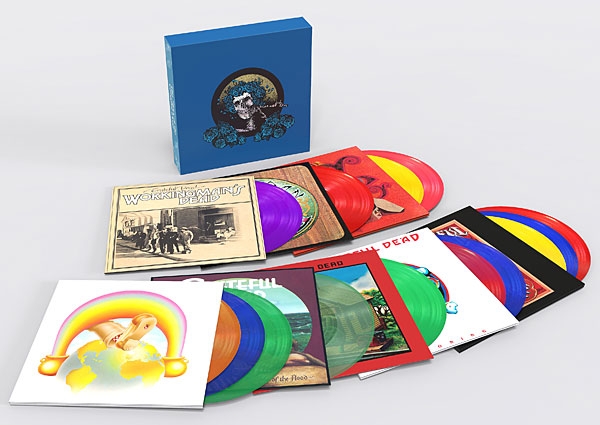| Columns Retired Columns & Blogs |
Great to know the sound is fantastic! The performances are legendary!

I remember buying Live/Dead at an old bookstore on E. 7th Street around the corner from the Fillmore East, run by a grizzled lower–East Side bouquiniste called Max. When I got home, my parents were out, so I put it on the old Magnavox console in the living room, which was used to play show tunes, Andy Williams, and Sinatra. Here it was, the Dead in all their glory, four sides of music that sounded like it belonged together and some of the most exciting guitar work I'd ever heard.
I've since listened to Live/Dead many times. Every note is burned into my brain. So, I looked forward to hearing this new pressing. After I got past the brilliantly colored vinyl, the first thing I noticed was that side one was backed by side two; side three by side four, instead of the sides being organized for a record-changer.
The music was better than the cliché, "like hearing it for the first time." I heard details in stark clarity that had only been suggestions before. Long-held understandings took on deeper meaning. The four sides have a symphonic coherence, connected by repeated leitmotifs played by Jerry Garcia in various mutations. The music flows from the white-light astral journey of "Dark Star" into the rich, earthy strides of "St. Stephen" and on to the giddying climb-ups of "The Eleven" and the all-out release of "Turn on Your Love Light." Garcia's manipulation of feedback is revelatory, at one point anticipating the music used to communicate with aliens in Close Encounters of the Third Kind.
Tom Constanten's symphonic keyboard work wove melodic phrases into the mix like tapestry. Phil Lesh played bass lines that rumbled up through the soles of my feet. Bob Weir's subtle rhythms and fills, sometimes no louder than whispers, added to the intricate interlace of the sound, and the two drummers, beautifully captured by engineer Betty Cantor, whipped and drove each other on like a team of matched horses barreling down a country road.
Pigpen gave the band a quality it lost after his passing: funk. On "Love Light," he's calling down the gods, talking in tongues, and driving Garcia to some of his greatest moments. The sly fills and comps Jerry lays down are another whole side of his genius.
And then they flipped the script, returning with two cornerstone recordings of Americana, Workingman's Dead and American Beauty. This is the flowering of the Garcia/Hunter songwriting team, when the Dead became essential to an ever-growing audience, the songs that provided the bulk of their live sets forever: "Uncle John's Band," "Cumberland Blues," "Friend of the Devil," "Truckin'." The sound is beautiful, although both of these records have been lovingly restored elsewhere, notably on Rhino's 50th anniversary reissues and Mobile Fidelity's 2-disc 45rpm rendition of American Beauty. The 3-disc live recordings from the Dead's 1972 European tour define the moment when the Dead became ubiquitous. I marvel to think how many millions of joints were rolled on that crazy Kelly/Mouse ice cream–cone-to-the-forehead cover of Europe '72 .
The 1973 release Wake of the Flood shows a band in transition. Pigpen's loss is reflected in the Garcia/Hunter ballads "Row Jimmy" and "Stella Blue." The new VMP pressing sounds fuller and has more presence than my original, still in shrink wrap with a price sticker from May's department store.
Next up is Terrapin Station, the first album for Arista, released in 1977. The well-recorded "Estimated Prophet," a Weir/Barlow original that shimmers in the audiophile light of producer Keith Olsen's brilliant vision, starts things off. The title piece, an extended suite written by Hunter, Garcia, and drummers Bill Kreutzmann and Mickey Hart, is the album's raison d'etre, the closest the Dead ever came to recording a masterpiece like Dark Side of the Moon or side two of Abbey Road. On this pressing, the strings breathe and the horns explode while the choral finale makes you flash No.9. Just enough.
Without a Net is the kind of overlooked gem VMP loves to spotlight. The Dead could be uneven in the years after Garcia recovered from a stroke that nearly killed him, but their high points could still rival their greatest moments. A number of them are collected on this 3-disc compilation from stadium shows in 1989/90. It shows a mature band at the height of its conceptual unity and improvisational powers, led by a game Garcia soloing in beautifully sustained crescendos. Branford Marsalis joins on saxophones for "Eyes of the World" in an exchange that shows the common ground Coltrane and Garcia shared. The set ends as it began, showcasing one of the greatest guitarists of the rock era.

Great to know the sound is fantastic! The performances are legendary!

Nice article. Their significant contributions to live and studio sound makes many of their recordings mind blowing. I saw the wall of sound system live, nothing since has been as emotionally engaging to me, it was a giant audiophile system... I think I have been chasing that experience, the clean presence and physical feeling of it. And just for the fun of it, to jump in a rabbit hole, I'm one of those guys who has an HDCD capable CD player because the Dead (Jeffrey Norman) use it on their releases to this day.